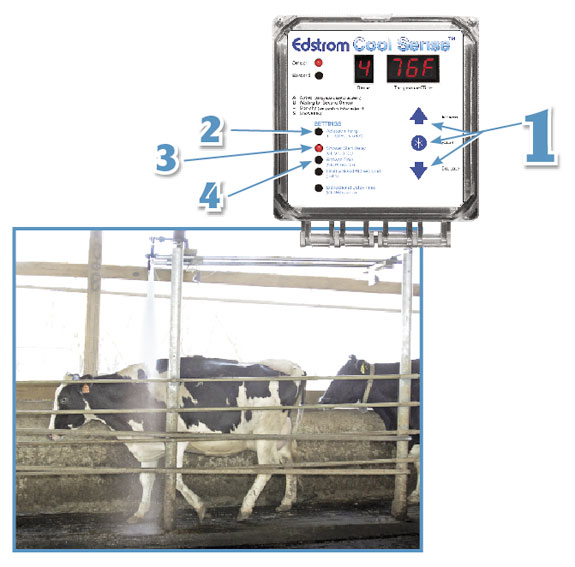Why is cow cooling important? Cooling dairy cows is important for several reasons. Cows enjoy temperatures in the range of about 40°F to 68°F. At temperatures above this range, cows use more energy to get rid of the excess heat. To get this additional energy, the cow must either eat more feed, use less energy for milk production or reproduction or convert body fat reserves to energy.

But when it’s hot, a cow will eat less, since digesting additional feed creates more body heat. If the cow is exposed to heat stress conditions for several days or weeks in a row, her ability to cool herself gets increasingly more difficult, and she is at risk to suffer more severe health conditions or possibly even death.
Unfortunately, cows are not as efficient as other animals who use sweating to remove body heat, so we need to provide supplemental cooling. If we can keep the cow cool and comfortable, she will continue to eat more normally, and this prevents the losses in production and reproduction. Remember that cows start to feel heat stress at temperatures in which people are comfortable.
How does showering actually cool cows?
Soaking cows with low-pressure shower nozzles at regular intervals throughout the day is a very effective way to help the cow maintain a more comfortable body temperature. Low-pressure soaking can be effective in both dry or humid environments. The water cools the cow by conduction as it comes in contact with the skin.
Think of this cooling as the effect we feel when jumping into a swimming pool, where the water temperature is cooler than our body temperature. When you get out of the pool and the air evaporates the moisture from your skin, you feel cooler. The cow feels the same thing from a low-pressure shower. By repeating the shower and cooling cycle throughout the day, we can greatly reduce the effects of heat stress. Adequate air flow over the cows is important to help speed the evaporation process. This will normally require the addition of fans in the barn to get the air speeds consistently fast enough to effectively cool cows.
How will I know when to cool cows?
Cooling should begin before the cow actually gets hot – generally at about 70°F (21°C). There are some early warning signs for heat stress that you need to be aware of.
- Cows spending more time standing than normal
- Cows bunching together
- Increased respiration rates (above 80 breaths per minutes in 7 out of 10 cows)
- Decreased feed consumption (a drop in dry matter intake of 10% or more)
How should I do it?
There are three main areas where cows should be showered. The first area is in the holding pen. The second area is at the feedline where they eat. The third area where cooling should take place is in the exit lane from the milking parlor. This is an ideal spot for showering because it will get each cow as cool and comfortable as possible as she returns to the barn. This will encourage cows to spend more time eating, drinking and laying down, rather than standing around trying to cool off.
Here’s how to operate a motion cooling system that cools each cow as she leaves the parlor. Don’t worry about getting employees wet. The dual motion sensors allow people to walk through the alley without activating a shower because they will only activate one sensor at a time. A cow will activate both sensors at once, which causes a shower to begin.
- Press the button to toggle through configuration settings. Then press the up or down arrows to change settings.
- Set the actuation temperature. If the air temperature is below the actuation temperature, the system will not activate a shower, so it can be left turned on even when it is too cool for showering the cows. (This system does not detect the body temperature of the cows.)
- Set the shower start delay. Ideally, you want to start soaking the cow from just behind her head to her rump. Setting the delay just right avoids spraying her in the face, which would cause her to stop or back up. If a slight delay is needed, it can be adjusted by tenths of a second to get the best accuracy.
- Set the length of the shower cycle. This should typically last only 1.5 to 2.0 seconds. PD
by Dick Bonner, Edstrom Industries, Inc.





